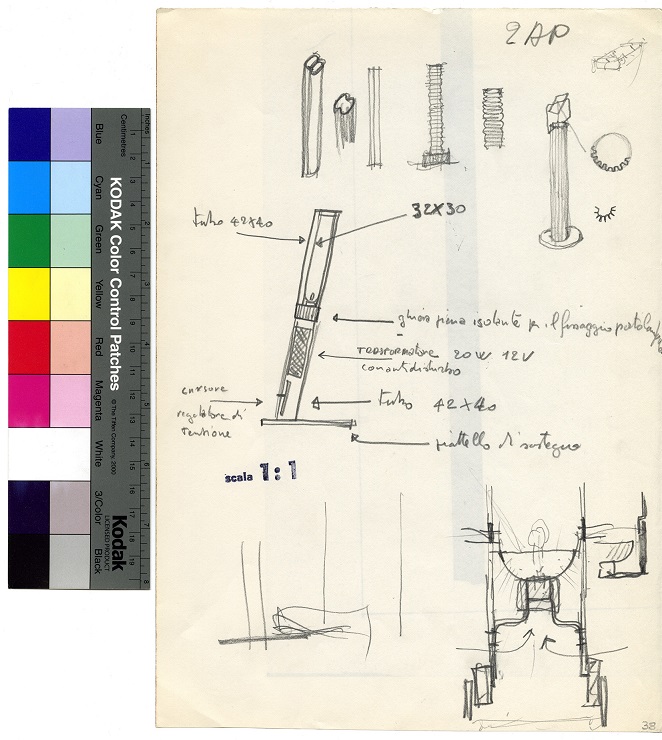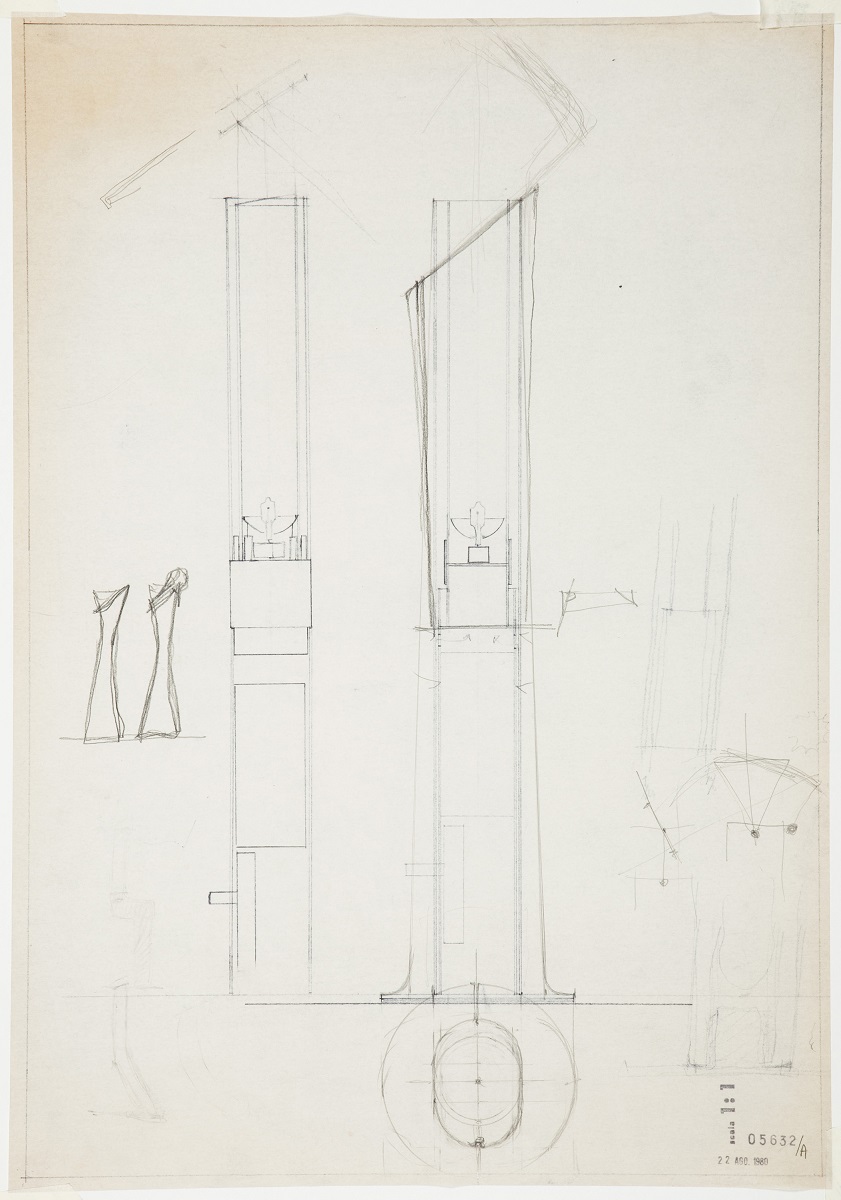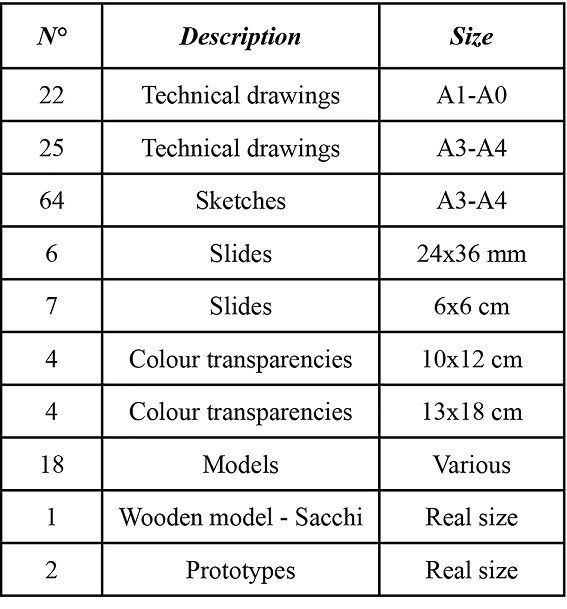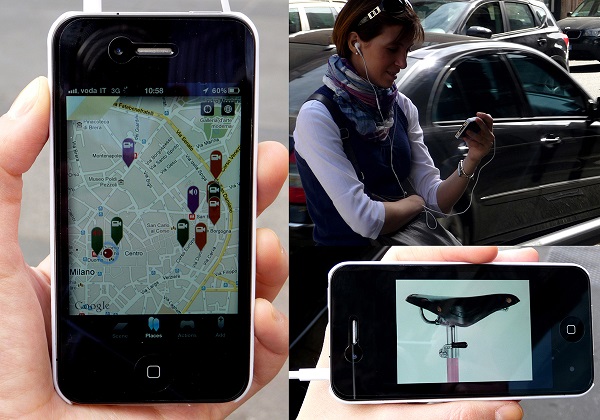1. Designer's studios and archives. An outstanding legacy
After World War II, Italian industrial design began to be recognised worldwide thanks to some courageous and visionary entrepreneurs who believed in it and entrusted talented minds with the design of their products. Many objects that were in daily use at the time are exposed in museums as design icons. However, what has become emblematic as evidence of an era and culture is only the object, the final product, while the cultural heritage to make widespread should not overlook the entire creative process that led to that particular form and the specific expertise that the Master of Design applied. Design understood as cultural heritage communicates on a large scale the objective value of the product itself and the value system in which it was generated. The exhibition of industrial products is undoubtedly an excellent starting point for spreading the design culture, but it is just as valuable to provide an adequate contextualisation. Public institutions and private foundations have created a culture around Design by organising exhibitions and debates on the subject and offering their spaces as a showcase for promoting "making Italian". Think of the Design Museum at the Milan Triennale, an exhibition, an attraction for visitors and a training centre for future designers, or the recently opened ADI Design Museum Compasso d'Oro. Nevertheless, in Milan, there are museums and professional studios, ateliers and workshops that have been transformed into foundations, such as the studios of Vico Magistretti, Franco Albini, Achille Castiglioni and the Giovanni Sacchi Archive. Places where there is a large number of documents, models, prototypes, and drawings from which it is possible to follow the evolution of the products and their creation step by step.
There has long been a debate on using and exploiting this heritage, identifying new cross-media approaches as technology is constantly evolving and creates innovative experiences in the cultural sector. Using custom applications, whether online or on-site, technology can provide content to an ever-growing audience, and museums and institutions have not missed the chance to experiment with this opportunity. Today, content reaches us everywhere, as expressed well by the term ubiquitous computing (Greenfield, 2006) [1], explicitly coined to indicate how ICT technology, found increasingly in new contexts and forms, will continue to affect daily life in unforeseeable ways.
The international online forum Narrare l'archivio (Narrating the archive), held in November 2020 in the middle of the pandemic, was organised by the Vico Magistretti Archive (NARRARE CON L’ARCHIVIO - Fondazione Vico Magistretti, 2020) [2]. The initiative aimed to investigate the possible multidisciplinary uses of archives in constructing historical narratives and how to design new research paths and learning tools; the topic was discussed with experts from different international institutions and allowed the collection of contributions in a shared panel.
This is the context analysed by a research project carried out at the Design Department of Politecnico di Milano. D.E.SY. (Designing Enhancement Strategies and Exhibit Systems for the Italian House Museums and Studios), aims to improve design strategies to enhance house museums and studios of artists and designers (faber). The focus of this study is a group of representative house museums and studios from the late 19th and early 21st centuries where designers and artists performed their creativity, and the places themselves could be considered the witness of their production and creative actions.
These particular and fascinating sites are therefore considered to be a well-recognised heritage even by museum protection and conservation institutions such as International Council of Museums ICOM. The locations involved, owned by public or private institutions, include house museums, ateliers and studios that could be considered museums for all intents and purposes but still reflect the narrative of their original function. The narrative of the original place is hidden but still traceable and could be recalled thanks to the visual documentation and other sources; they still include many aspects of their original everyday life and thus crucial historical witness and identity. Moreover, faber spaces, often animated by passionate heirs and curators, highlight the connection between the historical background of the owners, their lives and personalities, and the creative activities in that specific place.
2. Castiglioni & Sacchi: faber of the italian design
Among the many testimonies and case studies analysed, two deserve a prominent place in the story of the golden years of Italian design: the Fondazione Achille Castiglioni, a repository of extraordinary creativity with countless drawings, models and inspiration objects, and the model collection of Giovanni Sacchi. Castiglioni and Sacchi embodied the personification of the faber: throughout their lives, through drawing and modelling, they were able to shape an improved reality with intelligent projects, paying attention to fundamental issues such as functionality, industrial optimisation and communication; they contributed significantly to the development of Italian industrial design through different but strongly interconnected roles.

Fig. 1 Study sketches for the Gibigiana Lamp, digitised with Kodak target. Source: Image courtesy of Fondazione Achille Castiglioni - SIRBEC
Achille Castiglioni was an architect and a designer, whose education has been influenced by rationalism. As he reported in an interview with Piero Polato, he was not interested in being associated with a particular style, instead, he was trying to design with no preconceptions, but continuously asking himself the reasons for his actions. As long as they responded to easiness of production or handling or if the aim was to trigger a particular behaviour or meaning, then these were acceptable explanations, on the contrary, subjective motivations had to be avoided (Polato, 1991) [3]. Accordingly, Polano (2000-2002) [4] refers that Castiglioni was fascinated by the anonymous design of common objects and, in fact, a significant part of his work was dedicated to projects in which the subjective design coincides with the objective processes that usually inform and define common things, a practice that the author calls undesign. The world was his inspiration, indeed he used to say that design demands observation (Antonelli & Guarnaccia, 2000) [5] and, from this starting point, his iterative design process developed on papers, with plasticine and plaster. Drawing and modelling were his way of reasoning. In particular, prototypes were important steps to confront and test the tridimensional shape of the objects he was designing. This is why, working with Sacchi, in a collaborative way, was crucial in many cases.
Sacchi was not a designer, instead, he came to this world almost by chance. As a kid he was trained and became a foundry model maker and, despites the difficulties caused by the Second World War, he managed to have his own shop for mechanical models, until he first met Nizzoli (Polato, 1991) [3]. That moment marked the transition to a different approach: no more models with precise measures for the mechanical industry, yet, architects and designers needed prototypes to work with, to better understand strengths and weeknesses of their designs, but also to concretely present their ideas to the committers. This is how he began to realize models of study, verification and presentation (Consalez & Bertazzoni,1998 [6]; Maldonado, 1987 [7]; Salvarani, 1992 [8]), and to give a great contribution to Italian industrial design, by cultivating and sharing his experience troughout the process. It is no coincidence that many professionals of the time supported his candidacy for Compasso d’Oro, which he received in 1998 for his career. He was involved at all stages of the design process, and he was not a silent executor: he used to identify and correct the criticalities of a project, as well as he could understand and speak the same language of the designers even beyond what they were actually saying or drawing (Polato, 1991) [3]. Moreover, at the end, his models were so accurate that fooled people and they have been used even for commercial campaigns
Castiglioni and Sacchi have had flourishing careers, worked on a variety of projects and produced an immense amount of material that continues to reflect the expertise and thinking of their authors. Many have remained in their professional studios or workshops and constitute a heritage of incalculable value. The first step towards public sharing was the five-year agreement signed in 2006 between Achille Castiglioni's heirs and the Milan Triennale, which led to the Studio Museo Achille Castiglioni opening as an archive. In 2011, the Fondazione Achille Castiglioni was created, whose primary purpose is to catalogue, archive and disseminate drawings, photos, models, films, objects, books and magazines. (Fondazione Achille Castiglioni, n.d.) [9] Similarly, a collaboration between the Municipality of Sesto San Giovanni, the Fondazione ISEC (Institute of 20th Century Studies) and the Fondazione Cariplo led 2009 to the opening of the Archivio Giovanni Sacchi to collect models, products, drawings, photographs, documents, machinery and equipment from Sacchi's workshop. (Archivio Giovanni Sacchi, n.d.) [10] However, a visit to these two places alone is not enough to disseminate and enhance their contents, which remain not easily accessible due to their format, the characteristics of the materials, or the accessibility of the locations.
In order to enhance the cultural heritage located in these sites, we describe two pilot projects: the first aims to describe some icon objects through the digitalization and cataloguing of documents, drawings, models, and prototypes related to them. On the other hand, a second project focuses on the possible experience of consulting archival materials relating to Achille Castiglioni's projects located in downtown Milan, thanks to a geolocated smartphone application.
3. Digitization as a means of valorization and knowledge
The Triennale di Milano preserves Giovanni Sacchi's collection of 312 models owned by the Lombardy Region. Their cultural sector appointed the Design Department of the Politecnico di Milano to digitise some of the works to make them accessible to the public. Initially, we considered a simple 3D scan of the models to obtain physical copies produced using digital manufacturing techniques to exhibit and preserve the originals. Later, the project expanded to highlight the entire process of developing an industrial product, thanks to the testimony of well-known personalities on the Italian panorama. In fact, not only the memories of those who worked with the masters of design remain of the original design process but also sketches, drawings, drafts, models and prototypes that recount all the phases of project analysis and are a handy training tool for future designers. For this reason, we decided to reconstruct the entire design process through digitalisation. Among all the objects Sacchi modelled in his career, we chose those for which good documentation was available in studios or companies: first-order sheets, the inspirational materials used by the designer, the first sketches and all the materials created with increasing levels of detail, right up to the final product.

Fig. 2 Sketches and brainstorming on the Gibigiana lamp project. Source: Image courtesy of Fondazione Achille Castiglioni - SIRBEC
In order to test the relevancy of the process, six of Giovanni Sacchi's models were selected based on their relevance in the history of Italian design, as well as the availability of suitable materials and documentation: Lampada Gibigiana (1980, A. Castiglioni per Flos); Lampada Tama (1970-1977, I. Hosoe per Valenti); Sedia 4870 (1984, A.C. Ferrieri per Kartell); Sgabello 4822/44 (1977-1979, A.C. Ferrieri per Kartell); Marker Trattopen (1975-1976, Design Group Italia per Fila) e Telefono Rialto (1975-1976, Design Group Italia per Siemens).
We aimed to identify a sample methodology of digitisation applied to heterogeneous items from different sources and correlated to different design procedures and outcomes. Nowadays, digitisation is a common practice and can be easily performed with good quality thanks to digital technologies that have changed the way data can be created, distributed, stored and used. Digital libraries nowadays enhance traditional ones, giving access to the information they preserve ubiquitously through the web and possibly mobile devices. A great example of the effort to make cultural heritage accessible on the internet is represented by Google Arts & Culture project, which enables people to access several museums worldwide - exploiting its Street View Technology - and discover expert-created content. Institutions' real issues are about cataloguing data and making it accessible to expert users and the broader public on different platforms and systems. Some European projects related to this topic have been developed, such as Minerva, Michael, Michael Plus, Athena (Angelaki et al., 2010) [11] and Europeana (European Commission, 2009) [12]. In Italy, a regulation, defined by ICCD (Istituto Centrale per il Catalogo e la Documentazione), establishes norms to digitise images (Auer et al., 1998) [14] properly and records to catalogue the digitised data. More specifically, Regione Lombardia instituted SIRBeC (Sistema Informativo Regionale dei Beni Culturali), a regional cataloguing system (Degiarde, 2007) [13]. We developed our work according to three main steps considering the appropriate legislative rules: retrieval, digitization and cataloguing.
We retrieved and organized the documentation from the designers’ archives and from the companies producing the items. Our main focus was to collect all the materials useful to reveal the mental process that led to the final design, therefore we excluded the commercial ones.
We digitized all the material in different ways according to the nature of the products. We mainly used digital photography for wide size drawings (posters, technical, etc.); scanning for small size sketches and documents, slides and transparencies up to the A3 format; 3D laser scanning for Sacchi’s wooden models; and a 360° photography of one significant prototype. The entire process followed the Italian standards defined by ICCD (Auer et al., 1998) [14], overtaking the top level A, required for large prints and conservation as an high-quality digital copy of the original. Additionally, for a correct color calibration, every document has been digitized with Kodak gray-scale and colour targets. (Fig. 1)
We catalogued and stored the digitized material into the Regione Lombardia database, according to its cataloguing system for cultural heritage: SIRBeC. In particular, all the drawings, intermediate models, and final prototypes have been catalogued as works of art according to the record OA (Opera d’Arte), highlighting the artistic value of such production; while photos, slides and transparencies have been catalogued with the record F (Photographs). Additionally, the system provides a record Design (DES R.L.), linking all the digitized materials, that describes the overall project behind an industrial design product, the related documents, the subsequent restyled editions and the information about the author.
4. Gibigiana lamp. Storytelling through archives resources
The digitisation activity used to explore Castiglioni's work process is exemplified here by the case of the famous Gibigiana: this is a table lamp with an adjustable light that can concentrate at a particular point with the help of a mobile mirror. The apparent reference is the play of light sent back by a reflecting surface, called gibigiana in the Milanese dialect. Among the objects analysed, the Gibigiana is one of those with the most significant quantity of materials (drawings, slides and intermediate models - kept at the Fondazione Achille Castiglioni). (Fig. 3)
As the A0/A1 large-format technical drawings did not require very high resolution, digital photography was considered the best method for digitising them. We scanned them using a digital camera, with a minimum resolution of 240 dpi, in a customised professional set at LabImmagine - Department of Design, Politecnico di Milano. The same was done with the intermediate models at the Fondazione Achille Castiglioni, while the final one was photographed from different angles to obtain a 360° virtual image. On the other hand, Sacchi's precious wooden prototype was digitised at the Design Department's Virtual Prototyping and Reverse Modeling Laboratory, with the process of 3D scanning using a laser scanner. The acquired point clouds were processed to obtain a correct polygonal mesh, which was then appropriately textured to create a realistic 3D model viewable on screen. Small drawings, sketches, slides and transparencies were digitised using a flatbed scanner, carefully calibrated to ensure an accurate match between originals and digital copies, in uncompressed TIFF format with a resolution from 300 to 600 dpi for the former and 4800 to 2400 dpi for the latter. Small format originals were digitised at the Fondazione Achille Castiglioni to avoid any risks of damaging.
By reviewing and ordering all of these materials, the reconstruction of the process, from the early ideas to the final product, becomes patent. Like a growing creature, shape by shape, it narrates its story from the actual author’s point of view. Intuitions, inspirations, rethinking and distractions, everything has been impressed, especially on paper. Thus, exploiting the SIRBeC, the 180 records realized for the Gibigiana lamp (Lombardia Beni Culturali, n.d.) [15] enable people to detect its development in the subsequent phases, a positive opportunity not only for scholars and researchers, but also for design students who can profit by a mind-on and hands-on approach towards the design. Indeed, in some cases, Castiglioni’s bricoleur attitude (Levi-Strauss, 1962) [16], bringing him to the ready-made or redesigned production (Antonelli, 2000) [5], showed how he drew on existing objects to create new harmonious shapes; other examples demonstrate how some modifications derive from technical requirements to lower the cost; while sometimes suggestions and recalls to other objects that the designer would have developed later in his career can be highlighted, almost as a side note, on his drawings. (Fig. 2)
5. LfAC. Looking for Achille Castiglioni
Several months working in the Studio have clarified the enormous potential of all the material preserved here, not only in terms of world-renowned works but also in lesser-known ones. According to Fondazione Achille Castiglioni's aim to share the designer's immense legacy, we developed LfAC - Looking for Achille Castiglioni, a smartphone application that presents works in Milan's centre. (Spallazzo et al., 2011) [17] It guides users in discovering architectures, temporary exhibitions, installations and other projects that no longer exist in the place they once were in an engaging narrative experience. The multimedia data are linked to a specific point on the map and will appear when the user, located by the phone's GPS, approaches it. The geolocalisation service guides visitors along a route to points of interest with museum content, tracking users' behaviour and receiving helpful feedback for project evaluation.
We chose places and their description with the Foundation's curators based on the walking distance from the former Studio Castiglioni. The amount of descriptive material available led to 15 Points of Interest PoI. Each one is provided with a short audio description in Italian and English, and images and videos are available to build the iconographic narrative. The result is a mobile tour in which visitors move freely along a thematic route (architecture, industrial design, interiors) - identified by different colours. (Fig. 4) The app activates a short video for each Pol with an audio description of the building or project; simultaneously, images, photos, sketches and drawings scroll across the mobile phone screen to add information. The complete tour takes about one hour plus the time needed to move from one point of interest to another.
Users' opinions collected showed great interest in this kind of experience, especially for those who had previously visited Studio Castiglioni and could better contextualise their knowledge of its projects and working methods. A test that shows how famous designers can be better known through the dissemination of their working materials and the reconstruction of the development process of the design product, highlighted by the cultural content of the drawings, models and photos.
6. Conclusions
The valorisation of the cultural heritage in the archive materials makes it possible to recall the spirit of the faber, his creativity and technical ability, his way of proceeding and communicating. It makes all the materials accessible, preserving the originals, sometimes characterised by large formats or fragile materials.
As writers express their minds through their words, the masters of Italian industrial design - Castiglioni and Sacchi - put their souls into drawings and models that usually remain stored out of sight. Even if the described approach is just one in the panorama of the valorisation actions, it demonstrates how digitising those precious materials can be decisive for the declared intents, especially if presented and spread properly. Pointing at the core of the faber’s projects could add an immense value to the mere exhibition of the design outcome, and, as the approach can be pretty easy for the public and private institutions to perpetrate, the design process could genuinely become a represented cultural heritage.
Finally, digitisation is a way to make the faber's spirit live again and disseminate their knowledge: a heritage worth being (re)discovered. Nonetheless, these kinds of documents are still not so easy to interpret for ordinary people, leaving the potential of this work primarily unexpressed. However, digitisation of cultural heritage is not enough and citing Martien De Vletter, Associate Director of the Canadian Center for Architecture, “Finding ideas in a collection based on records with or without visual support will no doubt continue to be a creative and intellectual process that requires inventive researchers that are able to give meaning to collection material and to make connections between materials that others overlook.” (De Vletter, 2020) [18].

















